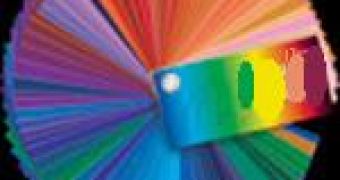This is the chameleon of the non-living materials: a newly structured gel created by a MIT team can quickly shift color reacting to an array of stimuli, from temperature to pressure, salt concentration and humidity.
"Among other applications, the structured gel could be used as a fast and inexpensive chemical sensor," said senior author Edwin Thomas, MIT's Morris Cohen Professor of Materials Science and Engineering and head of MIT's Department of Materials Science and Engineering.
A sensor like this would be good in food processing plants, where it could signal if dry food has been overexposed to humidity. Gel's main component is a material that expands/contracts when put in contact with various factors. The variations in the gel's thickness induce gel's color change passing through the whole range of the visible light spectrum.
The team started with a self-assembling block thin film consisting of alternating layers of two polymers, polystyrene and poly-2-vinyl-pyridine. The thickness of the polymer layers and their refractive indices were responsible for which color light will be reflected by the gel.
By maintaining the thickness of the polystyrene layer and changing the thickness of the poly-2-vinyl-pyridine layer in connection to external stimuli like pH and salt concentration, the team could change the gel's color in less than a second. "This is an ingenious and easy-to-implement method for making photonic materials whose optical properties can be readily tuned over a wide range," said Andrew Lovinger, director of the Polymers Program at the National Science Foundation, funder of this study.
The thickness of the poly-2-vinyl-pyridine (2VP) layer was controlled through positive charges delivered to the nitrogen atoms on each stretch of the 2VP block, resulting a polyelectrolyte polymer that can increase its volume to over 1,000 % its volume in water.
When the charges along the polymer molecule are electrically separated from each other (for example by inserting a high percentage of salt ions to the water that has permeated the gel) the 2VP molecule breaks into disordered tangles, like balls of string. By removing the salt ions, the 2VP positive charges again reject each other and the molecule stretches, making each 2VP layer to swell and the material to get another color by reflecting different light waves.
As the diblock polymer film is a one-dimensional periodic stack, volume shifts are restricted to one dimension, resulting a color change of 575 % in the reflected wavelength, a significant advance over previous color-shifting gels made of charged colloids in a 3D lattice structure.
Those gels swell in 3D, having a significantly lower spectrum of color change. The novel gel also reacts to variations in pressure, humidity and temperature.
"You can use mechanical or chemical forces to get really big responses, going through the entire range of light from ultraviolet (300 nanometers) to infrared (1600 nm)" said Thomas.
The team is also looking for a gel shifting color as a reaction to applied voltages.

 14 DAY TRIAL //
14 DAY TRIAL //